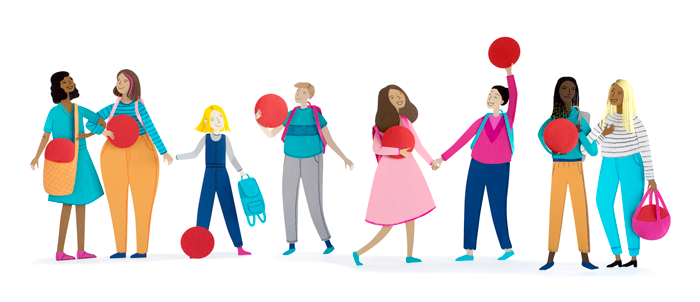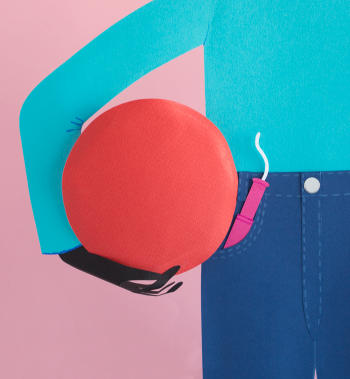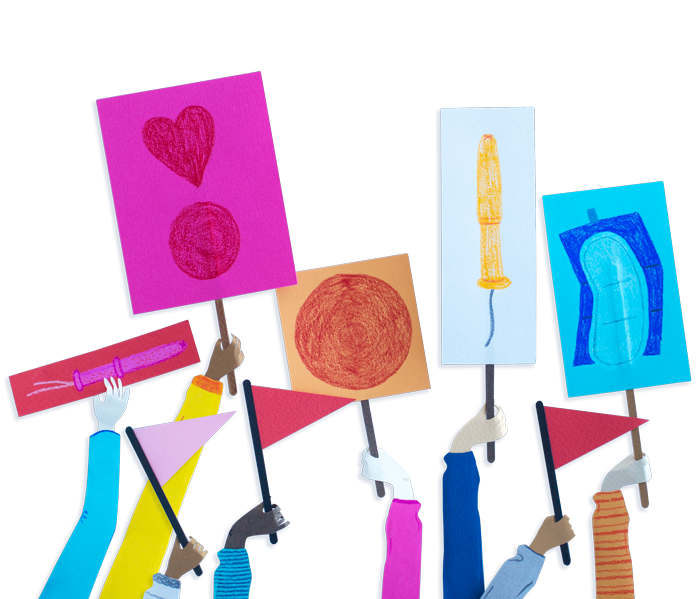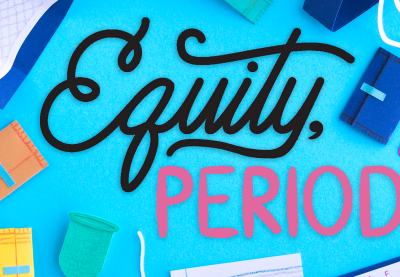At the beginning of the 2017-18 school year, middle school teacher Kristin Heavner shared on Facebook a photo of a colorful makeup bag filled with disposable menstrual products. She explained in the caption that she creates menstruation care packs for students. Since many educators follow her on social media, she thought it would be a good idea to remind them that middle school-aged students tend to have irregular menstrual cycles, which can mean unexpected periods or accidents at school. She didn’t think there was anything special about this public service announcement. After all, menstruation is a natural biological process that affects about half of all humans.
To Heavner’s surprise, the post went viral when it popped up on numerous blogs. The teacher had done a great deed, but most importantly, her post spiraled into a conversation about one of society’s most stigmatized topics.
It signified a small moment in a rising menstrual equity movement—one that aims to ensure anyone who menstruates has access to safe, environmentally friendly products, while also dispelling the shame associated with menstruation.
When we think about equity in the classroom, we envision ways teachers can give students from marginalized communities the right tools to flourish. Gender parity is also part of that—how to be cognizant of the messages we send students about their identities, their bodies and about the nature of gender and of sex assigned at birth. Self-awareness and education about these topics often begin at school. The stigma does, too. That’s why schools can be critical sites in the menstrual equity movement.
Heavner’s students, especially those who were too embarrassed to ask for a menstrual product, quickly opened up to learning and talking about menstruation—all because she offered a service without shrouding it in secrecy. In her homeroom class, students of all genders voluntarily helped fill the period packs.

“Once kids were talking about it a little bit more, they seemed a lot more comfortable to just kind of walk in, walk to the back to take one and walk out,” Heavner says. “There wasn’t a lot of hiding.”
In the United States, this sort of effort has been carried out by menstrual equity organizations that focus on schools, among other institutions, where people don’t normally have access to menstrual supplies. Some states are also addressing this issue, with at least 14—including New York, California and Illinois—passing laws to provide menstrual products for free in schools.
A History
Lack of menstrual equity is most often thought of as an issue in the Global South, where women may have limited access to menstrual products, be isolated and shamed, or miss work and school because of their periods. But menstrual advocacy in the United States can be traced back to the 1960s. For years it was considered a fringe movement, first propelled by health activists, consumer rights advocates, environmentalists and feminist spiritualists working to change the narrative about menstruation. It then spread to punk subcultures that fought against the exploitation of the menstrual cycle as a way to sell products.
By the mid-2010s, the movement had hit the mainstream. In 2015, phrases like “year of the period” and “the year the period went public” appeared commonly in the media. In Canada, officials stopped taxing menstrual products, a practice that requires women to pay inflated prices for personal care items.
“Just in the last years, it’s been on fire, frankly, which has been fascinating to me as someone who’s been studying this since the early 2000s,” says Chris Bobel, associate professor of women’s, gender and sexuality studies at the University of Massachusetts Boston and former president of the Society for Menstrual Cycle Research.
There’s a dearth of studies that show the economic and opportunity costs of menstruation for U.S. students, but activists point to numerous anecdotes that describe the struggles, including school absenteeism, barriers to accessing menstrual products and shame. According to Periods, Poverty, and the Need for Policy, one of the few research reports on the topic of menstrual equity, girls at the Pine Ridge Indian Reservation in South Dakota miss up to a week of school due to a lack of access to affordable menstruation products.
What Is Menstrual Equity?
“In order to have a fully equitable and participatory society, we must have laws and policies that ensure menstrual products are safe and affordable and available for those who need them. The ability to access these items affects a person’s freedom to work and study, to be healthy, and to participate in daily life with basic dignity. And if access is compromised, whether by poverty or stigma or lack of education and resources, it is in all of our interests to ensure those needs are met.” —Jennifer Weiss-Wolf, Periods Gone Public
Policies Ignore Periods

While menstruation is a reality for half of the population at some point in their lives, the experience is often trivialized or ignored in schools. Lack of consideration for menstruating students is evident in restrictive and—in some cases—dehumanizing restroom policies, the worst of which have become the subjects of whistle-blowing news reports. Most recently, a network of charter schools in the Chicago area came under fire for a restroom policy that led to menstruating students bleeding through clothing or developing urinary tract infections.
Dress codes, too, are rarely created with menstruating bodies in mind. The same charter school network criticized for its limited restroom breaks also required that students wear khaki bottoms only. With no option to wear darker pants or skirts, it became embarrassingly obvious when students—who already had to negotiate their trips to the restroom—bled on their clothing.
Changing the Narrative
Jennifer Weiss-Wolf is the women and democracy fellow and vice president at the Brennan Center for Justice at NYU School of Law, co-founder of the nonprofit Period Equity and author of Periods Gone Public: Taking a Stand for Menstrual Equity. A leading voice in the call for period policy, Weiss-Wolf crafted the menstrual equity framework as a way to shift the narrative around this issue and elicit the bipartisan support necessary for widespread change.
“In the global context, menstruation and menstrual intervention have traditionally been viewed through the lens of water, sanitation and hygiene. Many found that frame to be too limiting in light of the myriad cultural and societal and educational implications at hand,” Weiss-Wolf explains. “That has expanded now to include public health human rights framing, all of which are very powerful to apply. In terms of pushing for policy change here in the United States, though, I felt very strongly that all of those arguments—public health, water, sanitation, and hygiene and human rights—were going to fall short in the domestic policy context, and weren’t going to be an effective way to engage legislators on both the left and the right.”
Weiss-Wolf is gratified to see the menstrual equity framework growing in popularity: “The equity frame … puts menstruation in the context of civic participation, democratic engagement, educational opportunity,” she says. “It implicates all of those things in a way that I think goes to our common values as Americans. It harkens to the core issues of the Declaration.”
Socialized Shame
Perhaps bleeding through clothing or asking a teacher for a tampon wouldn’t be embarrassing in the first place if periods were better understood—a challenge in a society that doesn’t speak openly or neutrally about menstruation in public spaces. Students who menstruate often go out of their way to avoid letting anyone know they’ve gotten their period; those who don’t tend to behave as though they are disgusted by the very mention of it.
Conversations about menstruation typically happen at home or at a doctor’s office. When they do occur at school, it’s within the limits of health or sex education courses, where instructional time is limited, and it’s common to separate classes by binary gender. And even then, it’s unlikely that these conversations will provide students the information they need. According to a 2014 Centers for Disease Control and Prevention (CDC) study, more than half of American high schools and four-fifths of middle schools fail to teach the 16 essential sexual education topics CDC researchers recommend.
By the time a young person gets their first period, or menarche, they’ve already been socialized to believe there is something dirty and shameful about the process. In media, menstruating women are portrayed as moody, angry and isolating. Advertisements use the word “feminine” in the same breath as “sanitary” and “protection.”
All of these messages send a clear signal to menstruating students: Learn to hide this event. Even in the privacy of a bathroom stall, many are careful not to make too much noise while unwrapping a pad or tampon.
“I think, as educators, it’s our responsibility to help students understand that a shame-based response to a natural bodily process is a social construct, and we can push back against that,” Bobel says.
The Right Messages
Bobel notes that the current wave of menstrual equity activism is missing an opportunity to empower youth to have pride in their bodies. Adding menstrual education would be a helpful addition to curricula that explore both puberty and sex education.
“What’s important is that we as educators impress upon youth that their bodies are sites of power and pleasure and agency,” Bobel says. “And they can make up their mind and change their mind about how they feel about their bodies, how they want to care for their bodies. Right now, menstrual education is really about, ‘What do you do to clean up the mess?’”
To ensure the inclusion of transgender students—who may or may not be out—it’s important that teachers are thoughtful when speaking about menstruating bodies. Not all women menstruate, and not only women menstruate. Teachers must acknowledge that transgender students may have a hard time managing menstruation while escaping negative attention that could put them at risk of harm.
“That’s one reason why this gender-segregated menstrual health education, which is still common, is not a good option—because everybody needs that information,” Bobel says. “We really have to begin by recognizing that you can’t make assumptions about who is and isn’t menstruating.”
Bobel says she is pleased to see more people in more spaces paying attention to menstruation. She worries, however, that product-related campaigns are the lowest-hanging fruit and may distract from other dimensions of the menstrual equity movement.
“While I think caring for the menstrual body is important, I think we have to think beyond that to actually fight stigma,” she says. “Because as long as our agenda, this menstrual movement agenda, is fixed on products, access, cost, quality, we are not taking on stigma. We are accommodating it. We are saying the most important thing is to develop your capacity to contain [menstruation].”
Because students spend so much time at school, educators are in a unique position to help reframe the idea that menstruation is a punishment or a deviant function that makes bodies that menstruate inferior to bodies that don’t. Instead, schools can treat menstruation as an important process for everyone to understand—for the sake of body literacy and reproductive and sexual health.
Dillard is the staff writer for Teaching Tolerance.

How to Advocate for Menstrual Equity at Your School
Normalize menstruation. Adapt or create a curriculum that includes the menstrual cycle. Ensure all students and staff—regardless of sex or gender—understand the menstrual cycle.
Watch the language. Use correct terms instead of euphemisms such as “Aunt Flo” or “monthly visitor.” Shut down bullying that involves stereotypical references about a person’s temperament while menstruating (e.g., “PMSing”).
Don’t assume that any student—regardless of sex or gender—does or does not menstruate.
Think of menstrual products as school supplies. Stock bathrooms, nurses’ offices and classrooms with menstrual products, and make students aware of where they are stored.
Reconsider bathroom and dress code policies. Urge school administrators to create more than one option for school uniforms, and ensure no one has to wait to use the bathroom in the event of an emergency.
Seek help from organizations working to make products free and accessible in schools. Here are three:
• PERIOD. delivers period packs to people in need and offers education through a network of schools, colleges and community chapters.
• #HappyPeriod provides menstrual hygiene kits to people experiencing homelessness or poverty, including the LGBTQ community, teens, veterans and people with disabilities. The organization has chapters in New York City, Atlanta, Miami, San Diego, Chicago and Washington, D.C. People interested in the cause can raise funds or start their own chapter in their community.
• In the D.C. Metro area, Bringing Resources to Aid Women’s Shelters (BRAWS) delivers products to schools for people who cannot afford menstrual supplies.
